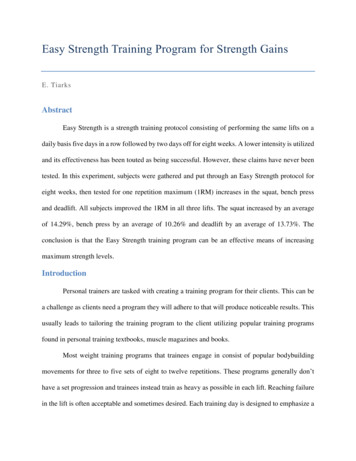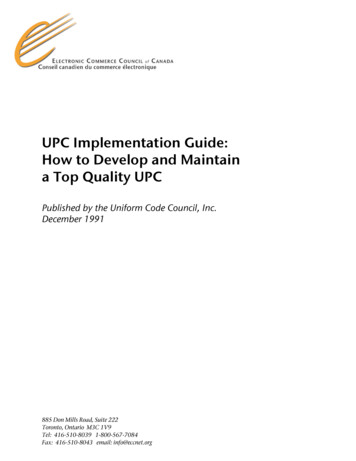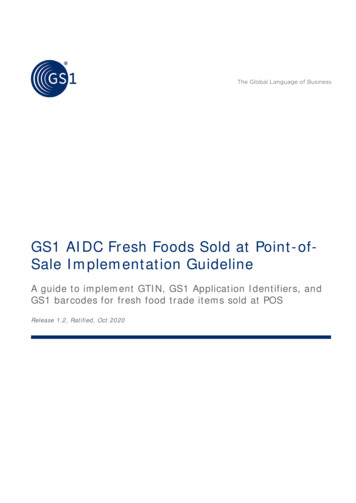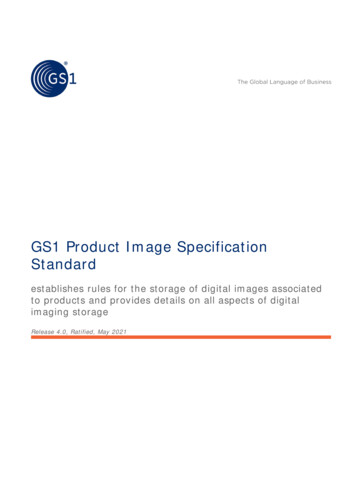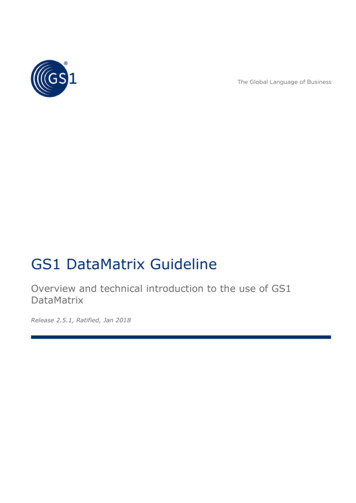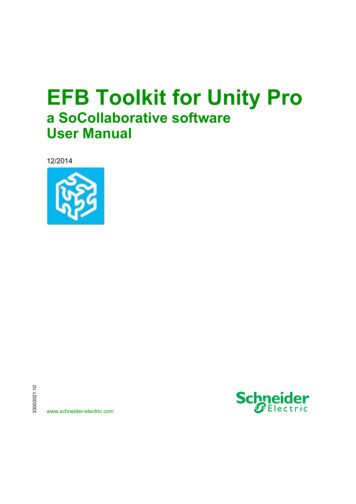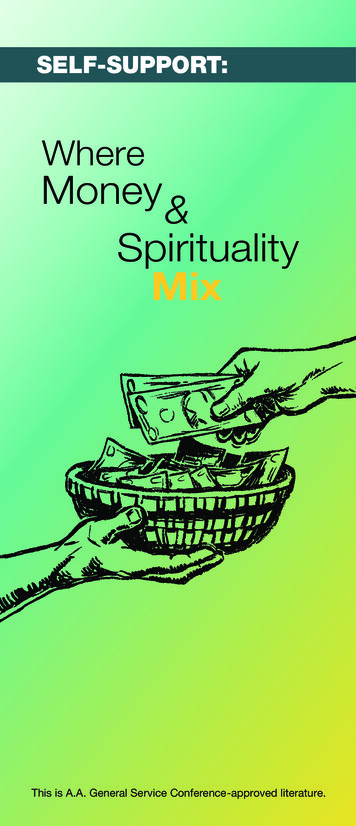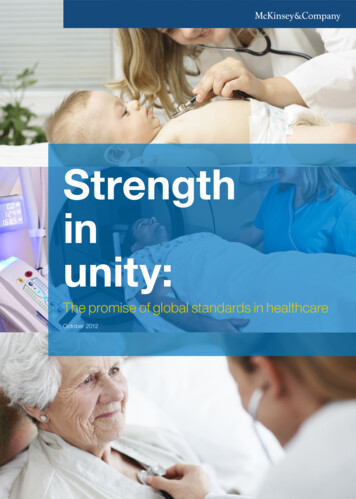
Transcription
Strengthinunity:The promise of global standards in healthcareOctober 2012
2
3October 2012Strengthinunity:The promise of global standards in healthcareThomas EbelKaty GeorgeErik LarsenEverett NealKetan ShahDavid ShiThe authors wish to acknowledge Manuel Bäuml, Jackie Hu, and Sherry Kan for valuable contributions tothe reportMcKinsey would like to thank GS1 for its contribution to the analysis and fact base which provide thefoundation of this report. McKinsey would also like to thank the interviewees for their expert insights.
4
Strength in unity: The promise of global standards in healthcareTable of ContentsExecutive summary 7An opportunity for a new kind of healthcare innovation 7The value at stake is significant in patient safety and supply chain efficiencies 8Every part of the healthcare value chain could benefit 9Collaboration: a vision of progress for patient benefit 10I.Introduction and context: Today’s healthcare supply chain 11Supply chain opportunities look bigger than ever 12An increasingly global marketplace means more complexity 14Quality and safety are more important than ever 15The healthcare industry faces a potentially costly patchwork of requirements 16II.Standards as foundation for change 17Global standards could help save thousands of lives and billions of dollars each year 18Global standards can support multiple stakeholder needs 21Learning from the retail industry: standards laid the foundation for transformation and value creation 25III.Global standards: The system-wide benefits to patient safety and healthcare efficiency 27Reducing medication errors 29Improving recall efficiency and effectiveness 31Protecting patients from counterfeit products 35Reducing inventory assets and associated costs 37Reducing product waste due to obsolescence 40Reducing data management cost 40Improving transaction accuracy 44Summary of benefits 45IV.Global standards: The benefits for individual organizations 47Pharmaceutical and medical device manufacturers 48Distributors and wholesalers 54Retail pharmacies 58Hospitals 60Impact of multiple standards 64V.A possible roadmap to adoption 65One approach for driving adoption 68Healthcare at a crossroads – strength in unity 71The patient would be the ultimate beneficiary 71VI.Glossary 735
6
Strength in unity: The promise of global standards in healthcareExecutive Summary7Executive SummaryAn opportunity for a new kind of healthcare innovationImagine a world where a patient’s records capture the brand, dosage, and lot number of each drug andmedical device she uses, along with the name of the physician who ordered the product and the nursewho administered it; where bedside scanning confirms that she gets the right product in the right dosageat the right time; where hospitals and pharmacies know the exact location of short-supply medicaldevices and drugs and when they can be delivered; where regulators can recall adulterated products withaccuracy and speed from every point in the supply chain; and where manufacturers can monitor real-timedemand changes and shift their production schedules accordingly.In this world, patients would enjoy consistently safer and more effective healthcare, with fewer mistakesand shorter average hospital stays. Redundant activities and costs would be driven out of the system– reducing the cost of healthcare to society and enabling broader global patient access to cuttingedge medical technologies. Doctors and nurses could spend less time with paperwork and more withpatients. Opportunities for innovation would open up – enabling new progress in personalized medicine,customized devices, and mobile health.This world is technologically possible today. But it has yet to become a reality because the healthcaresupply chain, from manufacturer to patient, remains fragmented, with limited visibility and interconnection.Certain channel partners are making progress by collaborating, and individual companies and evencountries are documenting excellent results with cutting-edge practices. But only a few players aremaking these innovations and advances. More widespread adoption will permit significant, cost-effectiveimprovements at scale. In fact, because these efforts are not consistent or global, they may actually raisethe cost and complexity of the global healthcare supply chain by spawning incompatible requirements andsystems.To build a world of interconnected cost-effective healthcare, the healthcare industry could align around asingle set of global standards that support the processes and capabilities required to achieve the kindsof benefits we describe. The consumer and retail industries have demonstrated the value of this kindof standards alignment with their adoption of GS1 standard barcoding, which has reshaped theseindustries and created billions of dollars in value. While new processes, tools and systems were requiredto deliver this value, usage of one single global standard was a critical prerequisite.New research by McKinsey & Company, conducted with the participation of more than 80 healthcareindustry leaders around the world, has estimated the potential value – in lives and dollars – of adopting asingle global standard in healthcare.This report presents those findings and also quantifies the investments each industry player would needto make to adopt global standards and the business benefits each player might reap, assuming globaladoption of a common standard and supporting processes. We point to some of the new insights,products and services that might arise from global standards, as they have in the retail industry. Wealso look to the precedent set by the consumer and retail industries to understand how leaders in thehealthcare space could begin aligning around a single global standard.
8The value at stake is significant in patientsafety and supply chain efficienciesGlobal standards that link geographies and stakeholders, frommanufacturer to patient, could help the industry improve patient safetyand the efficiency and effectiveness of healthcare systems.Using global product identification to match patients with drugs, forexample, could help hospitals reduce the number and severity ofadverse drug events, which, according to our research, now standat more than 25 million with over 100,000 deaths annually. Productrecalls, now occurring about 15 times per week in medical devicesand 20 times per week in pharmaceuticals in the U.S. alone, could bemanaged more efficiently and more comprehensively. Global productidentification could help reduce the growth of counterfeit drugs andallow faster responses upon detection in the supply chain. Globalstandards could supplement electronic medical records and supportthe management of the complexity associated with personalizedmedicine and customized medical devices.Furthermore, global standards could reduce the need for redundantinventories across the healthcare value chain. Today, the healthcareindustry has half a trillion dollars tied up in inventory, but bettercollaboration enabled through global standards could reduceobsolescence and inventory redundancy. Global standards couldenable inventory reduction of 60-94 billion and reduce the costs ofmanaging and storing inventory by 10-14 billion. Furthermore, it couldhelp reduce obsolescence by 19-27 billion.1However, the potential impact enabled by global standards goeswell beyond the use cases that we can identify and quantify today.For example, with global standards in place, payors, regulators andepidemiologists could learn more about the effectiveness of drugs,medical devices and treatments, improving health and yielding savingsat the institutional and even national level. End-to-end supply chainvisibility could create new opportunities in mobile health, helpingpatients to maintain their regimens, avoid drug interactions, and learnmore about products and how to order refills electronically for deliveryat home.1All financial figures in this report are in U.S. dollars unless otherwise noted.
Strength in unity: The promise of global standards in healthcareExecutive Summary9Every part of the healthcare value chain can benefitIn order to align around a single set of global standards, companies would have to come together acrossgeographies and parts of the value chain. The healthcare executives we spoke with acknowledge thatachieving this won’t be easy. They recognize that major players would need to agree on global standardsthat might differ from what they use today—and then adopt new processes and systems to make the bestuse of those standards.Some healthcare pioneers have already begun the journey. Certain pharmaceutical and medical devicemanufacturers and hospitals are now using global standards such as GS1 Global Trade Item Numbers(GTIN ), GS1 Global Location Numbers (GLNs), and data exchanges such as the GS1 Global DataSynchronization Network (GDSN ). Their approaches leverage standards as a foundation for collaborationacross the value chain – enabling new processes and capabilities that create both patient andbusiness value: Bedside scanning to match each patient, healthcare professional, and drug or medical device,reducing errors in the hospital; Efficient and effective recall administration using automatic identification and data capture along thesupply chain and at medication dispensing points and operating rooms; Medication authentication to help pharmacies, hospitals and physicians identify counterfeit drugsand reimbursement fraud; Inventory management collaboration between dispensing and usage points and manufacturers, andproduct availability data from manufacturers to pharmacies and hospitals; and Automated transaction and data-sharing that eliminate manual data entry, validation and correction,reducing errors and costs.We have reviewed more than 25 case examples of these kinds of collaborations. Our evaluation of theseexamples of early standards adoption suggests that even in these one-off applications, each participant inthe healthcare system “microcosm” generated significant benefits. Furthermore, our analysis of expectedinvestments and potential benefits that could accrue to each player in the healthcare value chain indicatesthat all parts of the system could achieve a positive return on investment from adopting global standardsand enabling business processes – if a “critical mass” of channel partners adopt the same standards.In other words, global standards adoption is not a “zero-sum” game in healthcare: benefits could beshared across the value chain, given sufficient adoption and standardization. We also estimated the costimpact for players to work with multiple standards and found that, even if players needed to support twostandards rather than one, the additional one-time investment and ongoing operating cost impact couldbe significant.
10Collaboration: A vision of progress for patient benefitWhile our research indicates that all healthcare players could benefit from global standards, aligningaround a single standard presents inherent challenges. In the consumer packaged goods industry,large global players collaborated and negotiated to set standards for the rest of the industry. Thehealthcare industry, however, is much more regional and fragmented. While a few major retailerscould set expectations and requirements for consumer packaged goods suppliers, manufacturersrepresent the largest and most global segment in healthcare. Healthcare is also more heavilyregulated. Indeed, some regulators are already defining standards to meet national rather thanglobal goals, creating a range of sometimes conflicting requirements, although there are alsoefforts at harmonization, such as the International Medical Device Regulators Forum for globalharmonization of medical device regulation, and the European Commission for harmonization ofserialization of pharmaceuticals across the EU.Many of the leaders we interviewed are keen to help the industry move up the adoption curvein healthcare. They are united by a collective commitment to improving patient safety. Theyunderstand that achieving this improvement will require a concerted effort by industry leaders whowork across competitive and customer-supplier relationship boundaries to agree on a commonvision and approach. They expressed a need for a deeper understanding of the requirementsand the benefits and costs of global standards. Some are already considering how to leverageglobal standards to do more than comply with regulations: they aspire to create distinctive valuein customer and patient service and relationships. As a group, they are very interested in workingtogether to define a collective strategy and approach for standards alignment, adoption and benefitscapture and a growing understanding that this must include the selection of a single global systemof standards.In this paper, we present an objective assessment of factors that industry leaders might consider inthis effort.“Supply chain data standards will greatly improvehealthcare safety and efficiency, but safety is ourprimary value. The needs of the patient come first.”-Medical device executive
Strength in unity: The promise of global standards in healthcareI. Introduction and context: Today’s healthcare supply chainI.11Introduction and context:Today’sHealthcare Supply Chain
12Supply chain opportunities look bigger than everHealthcare organizations have sometimes been slow to recognize the importance of supply chainimprovements. Some manufacturers have worried more about keeping their pipelines full than aboutexcess inventory or inaccurate demand forecasts, for example. Hospitals, many facing significantconstraints in financial and human resources, necessarily have often focused more on patient care than ontracking drugs and medical devices from pharmacy to bedside.Healthcare leaders are now beginning to understand how basic supply chain i
McKinsey would like to thank GS1 for its contribution to the analysis and fact base which provide the foundation of this report. McKinsey would also like to thank the interviewees for their expert insights. Strength in unity: The promsi e of gol bal standards in heatlhcare October 2012. 4. Strength in unity: The promise of global standards in healthcare Table of Contents 5 Executive summary .
